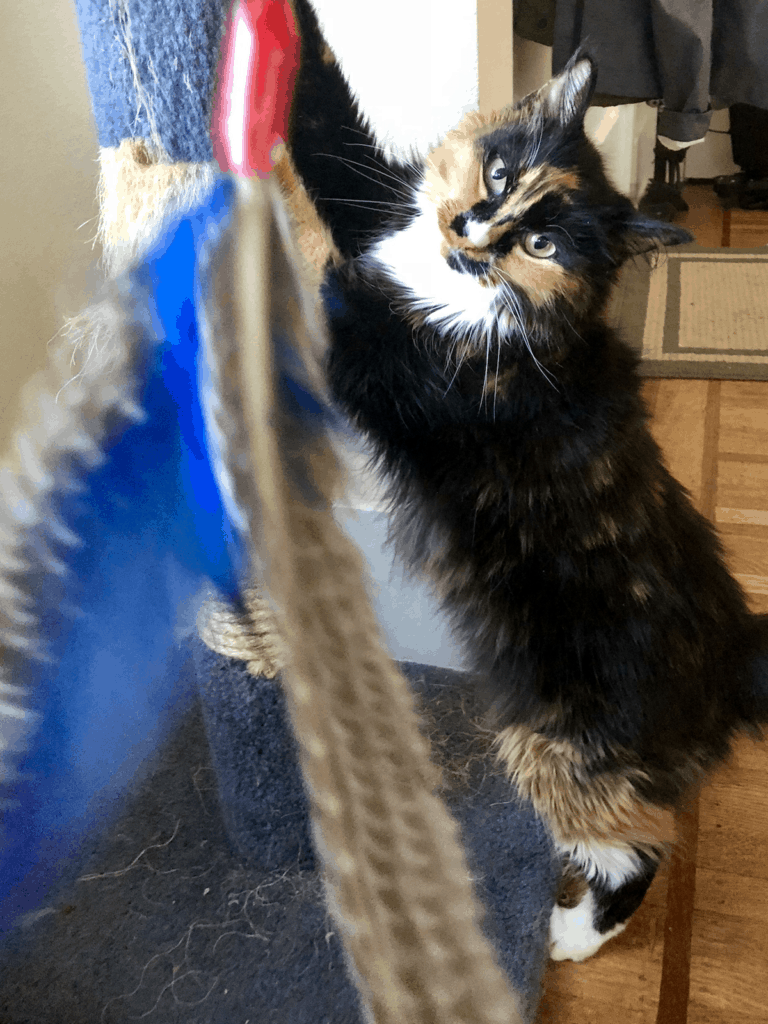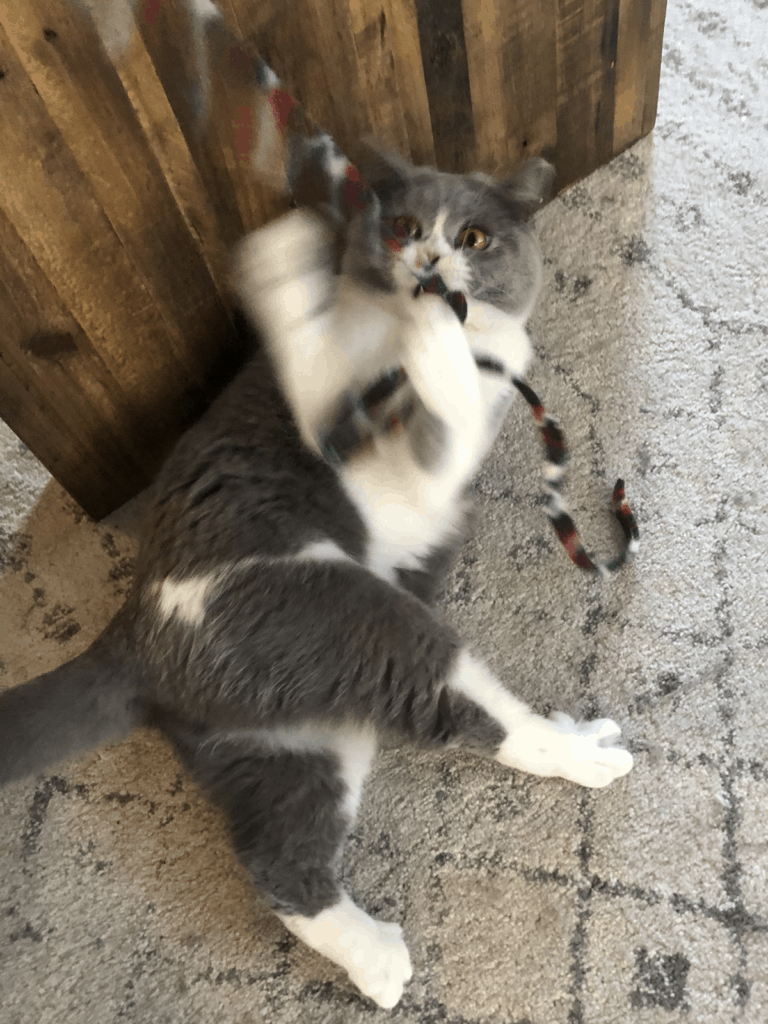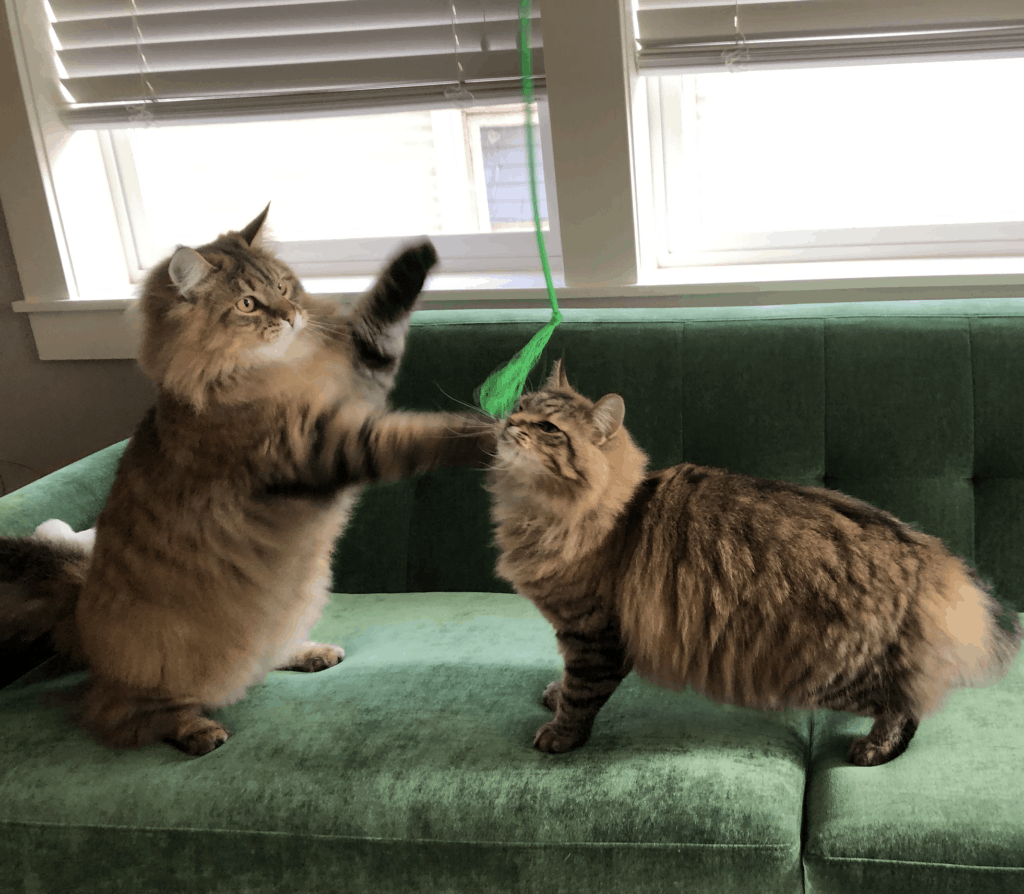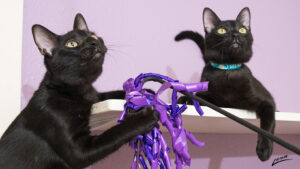The following is a guest blog post from Roar, a shop for cat lovers in Portland, Oregon.
We are BIG fans of wands and not just because they “sound” MAGICAL. We sincerely believe that interactive play using wand toys works WONDERS for cats!
Why is interactive play with WAND TOYS so important?
Cats have an innate instinct to HUNT. Both “indoor-only” cats and “sometimes-outdoor” cats need play opportunities that mimic “prey.”
When indoor cats lack a variety of play opportunities, it can lead to boredom, frustration, depression, stress, and behavioral issues.
For cats who sometimes go outside, we’ve found that increasing interactive indoor playtime leads to less hunting and fighting when they’re outside. Plus, we’ve found that the more enrichment options inside, the less desire to want to go outside!
You might already have a lot of cat toys around the house, but unless they’re moving, your cat might start to see them as “dead prey.” We call these toys “solo-play” options because your cat has to bat at them to create action, which is great SOME of the time but not ALL of the time!
Ideally, you want a nice mix of both “solo-play” and “interactive play” toys. After all, there’s no such thing as a cat who doesn’t like to play! Every cat has a different play preference, so it’s important to find your cat’s interests AND to have a variety of options.

Top 10 Benefits of Interactive Playtime with a Wand Toy
- Major boredom buster because it’s so much fun!
- Provides a variety of opportunities to hunt, chase, and play
- Great outlets for instinctual hunting behaviors
- Great for opening up shy cats and building trust
- Encourages exercise that keeps your cats healthy and alert
- Fantastic mental stimulation
- Confidence builder
- Positive relationship building for multiple cats
- An easy way to release pent-up energy and/or anxiety
- Regular play sessions strengthen the bond between you and your cat
But why is it important to stimulate my cat’s “hunting instincts”? I only want my cat to be a cuddle bunny!
Part of having a successful relationship with our cat(s) is compromising- – satisfying both our needs and theirs. All cats have hunting in their DNA. Playing with wand toys lets your cat act like the hunter she was born to be. Plus, interactive play is healthy in the same way that exercise is healthy for us.
What exactly are wand toys?
A wand toy consists of:
- a pole
- a string
- and oftentimes, an attachment toy at the end
There are generally two types of wand toys:
- A wand/pole with a clasp at the end of the string that allows you to attach various toys/“prey” (multiple brands, textures, materials, and sizes).
- One-piece wand/poles have no ‘moving parts’; they are a single unit, with pole, string and toy all in one.
What type of wand toy is best?
We like many types, and all of our cats are VERY different in their preferences. Sometimes it will take several types before you figure out what your cat likes. And just like us – your cat’s choice can change over time.
VARIETY IS THE SPICE OF LIFE!
And that goes for felines, too! For example, our kitty crew has their own purrr-sonal preferences: Lennon only has eyes for the rainbow “Cat Charmer” wand. Our cat Bernie is visually impaired and loves the sparkly tassels and attachments that make noise. Harmony enjoys the “Cat Catcher mousie”, Beyonce loves Dezi Roo’s “Wiggly Squid”, and Arthur prefers anything with feathers!
How often do I play?
We recommend consistent, regularly scheduled playtime. Start with five-minute a day sessions, working up to 15 minutes or more, depending on your cat’s needs (and your schedule). Several play sessions per day are ideal. Just like a dog needs a walk, a cat needs playtime!
How many wand toys do I need?
We recommend that cats who enjoy playing with wand toys have at least 5-7 different attachments, but start with a few (of varying textures & “prey choices”) and your cat will thank you for it!
ROAR has an entire wall of wand toy attachments at our Portland store with over 36 varieties, plus 5 interchangeable pole options, and 7 all-in-ones (pole w/string and/or attachment toy built-in/not interchangeable) options.
About 20 of these are on the online store, however, we can ship (almost) anything you see in our social media. Just ask us, and we can lead you in the right direction!
How do wand toys work?
You hold the pole and move the interactive toy so that the target at the end of the string wiggles, slides, darts, creeps or flies around the room. When you move the toy like prey, it will stimulate the hunter in your cat.
Let your cat stalk the toy quietly. Give her time to size up the prey before the chase begins. Try to move the toy away from or across her visual field, as this will most realistically mimic the prey and get your cat moving.
Don’t dangle the toy right in front of your cat’s face! This is annoying to most cats. Experiment with movement and speed—for example/ quick movements followed by slow crawls. Keep in mind that cats’ vision is best at least 12” away from their eyes. Any closer and they “see” with their whiskers.
TIPS FOR BEST “INTERACTIVE PLAY” EXPERIENCE
LANDING PAD
While we suggest trying all types of play locations, we’ve found that the majority of cats like having a soft, immovable surface (like a rug, carpet, or mat) to land on, especially if they like to catch some air!
BE CREATIVE
Slide the wand attachment under a rug or tissue paper, in/out of a box, bag, mat or tunnel, through the air, and across the floor. Pop it around slow, fast, etc!

ATTACHMENT TOY = “PREY”
A mouse attachment usually drags across the floor, but in our house, our cat Harmony loves Mr. Mouse to fly!
Match the toy to your cat’s personality! You’ll soon see what your cat(s) prefer, and if you have multiple cats as we do, you’ll soon discover that all are VERY different.
SUCCESS (aka “wins!”)
Let your cat catch the toy. Exercise is part of the equation, but so is “the game”. “Stalk-chase-pounce-kill” is the hunting sequence that cats love, and it’s not fair if they can’t ever “kill” their prey. Catching the prey attachment = a successful hunt.
ENDING THE GAME
Don’t just suddenly end playtime abruptly. That can lead to a frustrated cat who hasn’t had her needs met. Wind down naturally, then leave your cat with one final capture. Some cats will want to walk away with “their kill” in their mouth once caught, others will want to hold it, bat at it and/or put their mouth around it for a bit. Let them do this (supervised of course). Depriving them of this might cause irritation because this final step completes their hunt. They will show you when they are done, and at that point, you can re-start the game or end it and store the wand.
STORAGE
Make sure to put wand toys up when they are not in use! Make it a special time between you and your cat(s), so they will not take it for granted. Plus, wand toys can injure cats. String can get wrapped around body parts, and attachments can get eaten. Not to mention, mice and birds don’t hang out limply in plain site for cats to catch all day. Besides, that takes away the fun if there’s no challenge!




